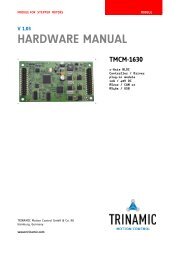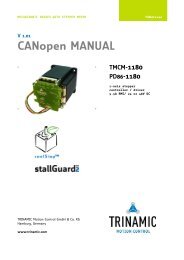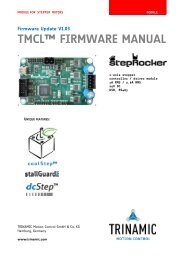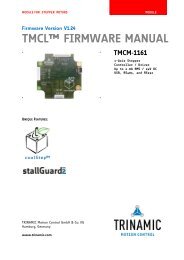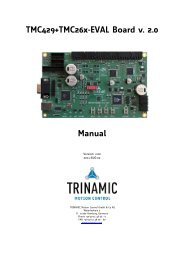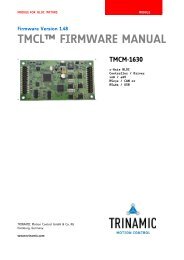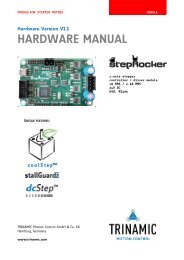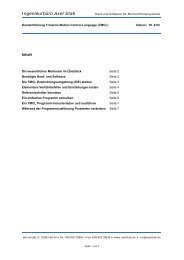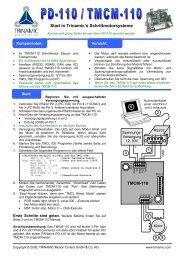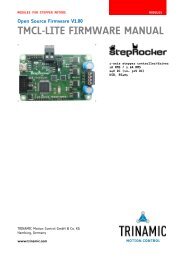TMCM-351 CANopen Firmware Manual - Trinamic
TMCM-351 CANopen Firmware Manual - Trinamic
TMCM-351 CANopen Firmware Manual - Trinamic
You also want an ePaper? Increase the reach of your titles
YUMPU automatically turns print PDFs into web optimized ePapers that Google loves.
<strong>TMCM</strong>-341/342/343/<strong>351</strong> <strong>CANopen</strong> <strong>Firmware</strong> <strong>Manual</strong> (V1.04 / 2011-AUG-01) 53<br />
7.3 Homing mode<br />
This clause describes the method by which a drive seeks the home position (reference point). There<br />
are various methods of achieving this using limit switches at the ends of travel or a home switch in<br />
mid-travel. Some methods also use the index (zero) pulse train from an incremental encoder. The user<br />
may specify the speeds, acceleration and the method of homing.<br />
There is no output data except for those bits in the statusword, which return the status or result of<br />
the homing process and the demand to the position control loops.<br />
There are four sources of the homing signal available: These are positive and negative limit switches,<br />
the home switch and the index pulse from an encoder.<br />
Figure 7.2 shows the defined input objects as well as the output objects. The user can specify the<br />
speeds, acceleration and method of homing. There is a further object home offset, which allows<br />
displacing zero in the coordinate system for the home position.<br />
Controlword 6040h<br />
Homing method 6098h<br />
Homing speeds 6099h<br />
Homing acceleration 609Ah<br />
Home offset 607Ch<br />
Homing<br />
method<br />
Copyright © 2011, TRINAMIC Motion Control GmbH & Co. KG<br />
Statusword 6041h<br />
Figure 7.2: Homing mode function<br />
Position demand internal value 60FCh<br />
or<br />
Position demand value 6062h<br />
By choosing a homing method, the following behavior is determined: the homing signal (positive<br />
limit switch, negative limit switch, and home switch), the direction of actuation and where<br />
appropriate, the position of the index pulse. The home position and the zero position are offset by<br />
the home offset.<br />
For the operation of positioning drives, an exact knowledge of the absolute position is normally<br />
required. Since for cost reasons, drives often do not have an absolute encoder, a homing operation is<br />
necessary. There are several application specific methods. The homing method is used for selection.



